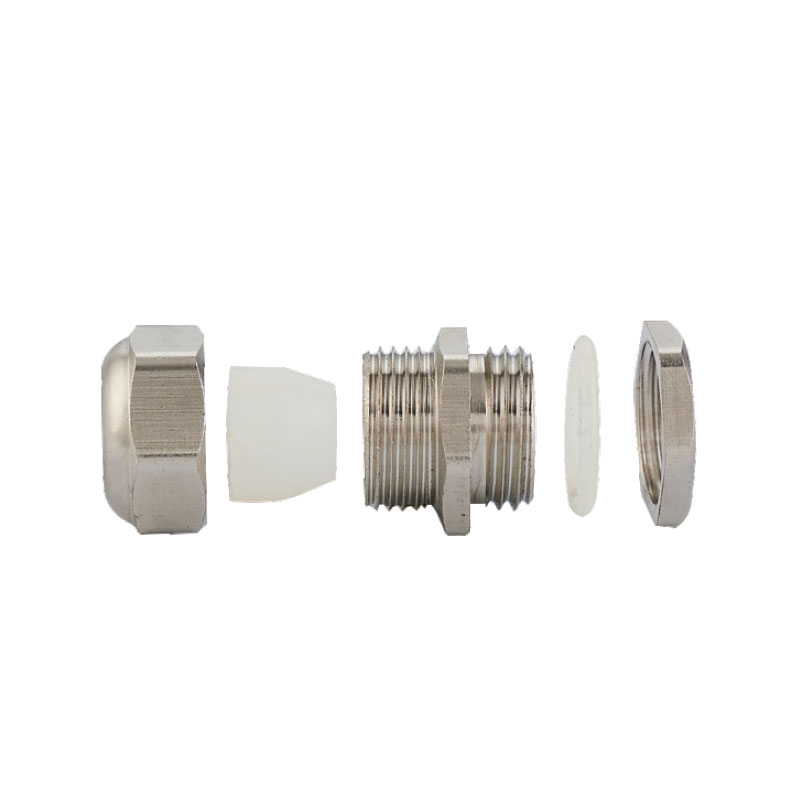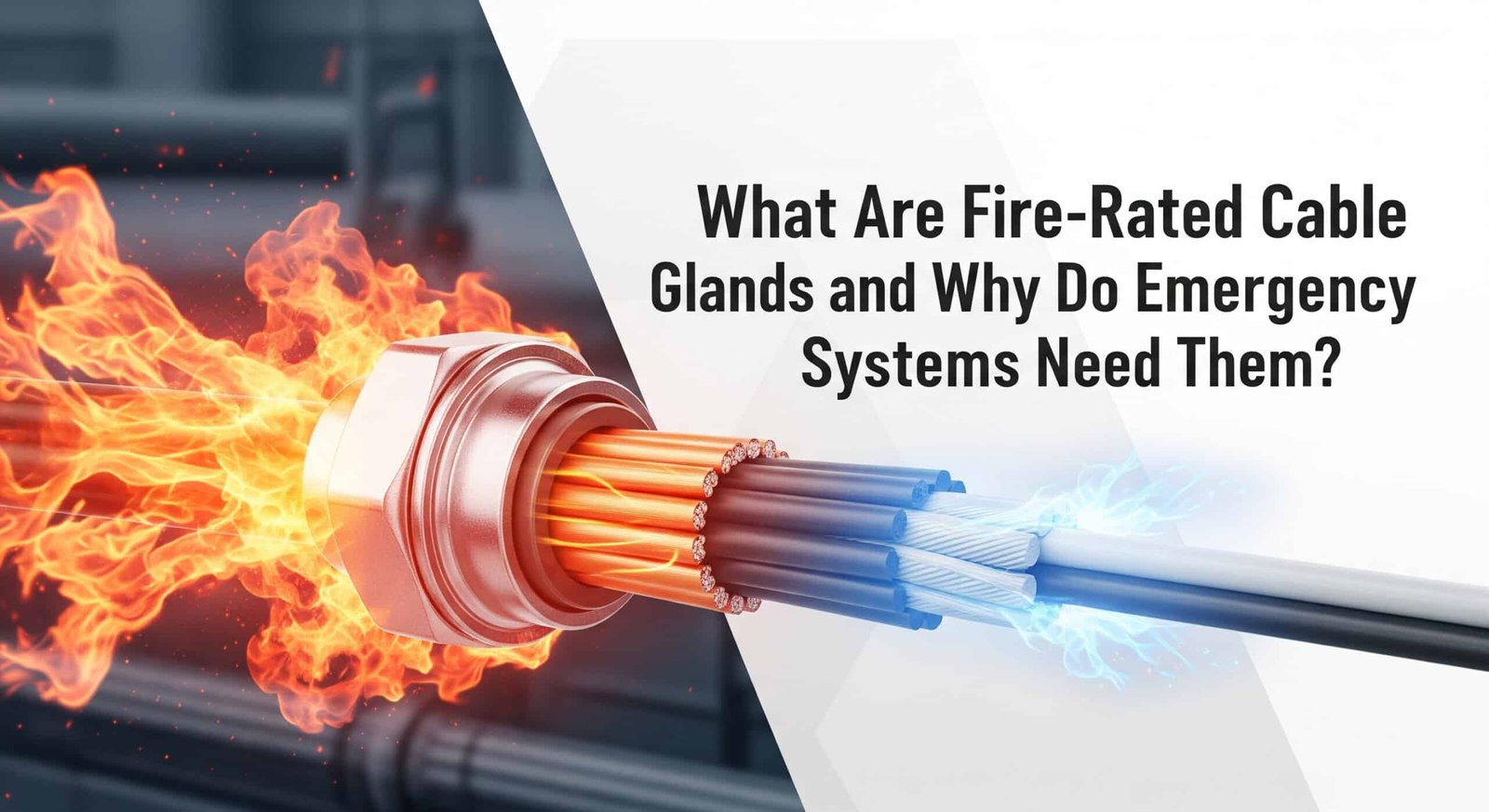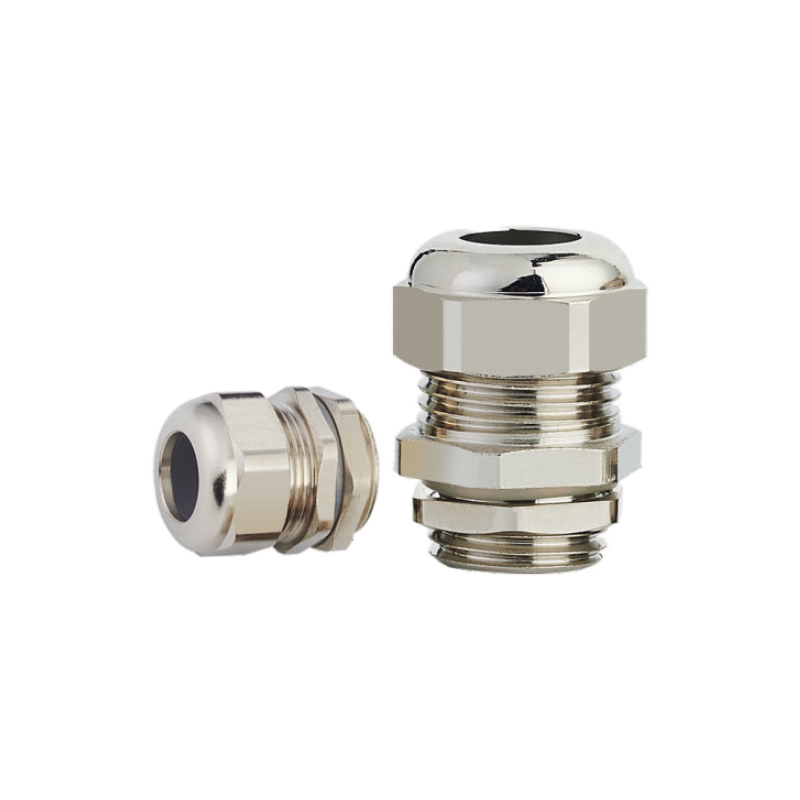Emergency system failures during fires cost lives and billions in property damage annually when standard cable glands fail under extreme heat, cutting power to critical safety equipment like fire pumps, emergency lighting, and smoke extraction systems within minutes of fire exposure. Many facility managers underestimate the importance of fire-rated cable connections, assuming standard IP-rated glands provide adequate protection, leading to catastrophic safety system failures when they’re needed most.
Fire-rated cable glands meeting IEC 60331 standards maintain circuit integrity1 for 90-180 minutes at temperatures up to 750°C, ensuring emergency systems continue operating during fires by protecting cable connections with specialized fire-resistant materials, intumescent sealing compounds, and heat-resistant metallic construction that prevents flame penetration and maintains electrical continuity. These specialized glands are essential for life safety systems in hospitals, airports, tunnels, and high-rise buildings.
Having worked with emergency system contractors, fire safety engineers, and building owners across Europe, North America, and Asia—from London Underground stations to Dubai International Airport—I’ve seen how proper fire-rated cable gland selection directly impacts life safety and regulatory compliance. Let me share the critical knowledge every safety professional needs for protecting emergency systems.
Table of Contents
- What Makes Fire-Rated Cable Glands Different from Standard Glands?
- Which Fire Rating Standards Apply to Emergency System Cable Glands?
- How Do You Select the Right Fire-Rated Cable Gland for Your Application?
- What Are the Installation Requirements for Fire-Rated Cable Glands?
- How Do You Maintain Fire Rating Compliance Throughout System Life?
- FAQs About Fire-Rated Cable Glands
What Makes Fire-Rated Cable Glands Different from Standard Glands?
Fire-rated cable glands use specialized fire-resistant materials, intumescent sealing systems, and heat-resistant construction that maintain circuit integrity and prevent flame penetration for specified time periods at extreme temperatures, while standard glands fail within minutes of fire exposure.
Understanding these critical differences is essential because standard cable glands that perform well in normal conditions become safety hazards during fire emergencies.

Fire-Resistant Material Construction
Heat-Resistant Metals: Fire-rated glands use specialized alloys and heat-treated materials that maintain structural integrity at temperatures exceeding 750°C for extended periods.
Intumescent Sealing Systems: Advanced sealing compounds expand when exposed to heat, creating an insulating barrier that prevents flame and smoke penetration through cable entries.
Ceramic Fiber Insulation: High-temperature insulation materials protect internal components and maintain electrical continuity during fire exposure.
Fire-Resistant Polymers: Specialized plastic components resist combustion and maintain mechanical properties at elevated temperatures unlike standard nylon or PVC materials.
Circuit Integrity Performance
Electrical Continuity: Fire-rated glands maintain electrical connections for specified time periods, ensuring emergency systems continue operating when needed most.
Insulation Resistance: Fire-resistant materials prevent electrical faults and short circuits that could disable emergency systems during fires.
Mechanical Stability: Gland components resist thermal expansion, warping, and structural failure that could compromise cable connections.
Flame Barrier Protection: Specialized sealing prevents fire propagation through cable pathways, maintaining compartmentalization2 critical for building fire safety.
Testing and Certification Requirements
Standardized Fire Testing: Fire-rated glands undergo rigorous testing to international standards including IEC 60331, BS 6387, and UL 2196 for verified performance.
Duration Ratings: Products are certified for specific time periods (30, 60, 90, 120, or 180 minutes) based on emergency system requirements and building codes.
Temperature Specifications: Testing validates performance at specific temperatures (750°C, 950°C, or 1000°C) depending on application requirements and fire scenarios.
Third-Party Certification: Independent testing laboratories verify performance claims and issue certificates required for regulatory compliance and insurance approval.
I remember working with Sarah, a fire safety engineer at a major hospital in Manchester, UK. During a facility upgrade, her team initially specified standard IP68 cable glands for their emergency power systems to control costs. However, during the design review, we discovered that UK building regulations required fire-rated connections for life safety systems. After switching to our IEC 60331-certified fire-rated cable glands, the hospital achieved full regulatory compliance and passed all fire safety inspections. The upgrade ensured that critical systems like operating room power, emergency lighting, and fire pumps would continue operating during a fire emergency, protecting both patients and staff. 😊
Performance Under Fire Conditions
Smoke Sealing: Fire-rated glands prevent toxic smoke infiltration through cable entries, maintaining safe evacuation routes and protecting sensitive equipment.
Thermal Shock Resistance: Rapid temperature changes during fire suppression don’t compromise gland integrity or electrical connections.
Water Resistance: Fire-rated glands maintain sealing effectiveness when exposed to fire suppression water, preventing electrical faults and system damage.
Chemical Resistance: Exposure to fire retardants and combustion byproducts doesn’t degrade sealing materials or compromise performance.
Which Fire Rating Standards Apply to Emergency System Cable Glands?
IEC 603313 provides the primary international standard for fire-rated cable glands, with regional standards like BS 6387, UL 2196, and EN 50200 specifying additional requirements for circuit integrity, flame resistance, and mechanical performance under fire conditions.
Understanding applicable standards is crucial for regulatory compliance and ensuring adequate protection for specific emergency system applications.
IEC 60331 International Standard
Circuit Integrity Testing: IEC 60331 specifies test methods for maintaining electrical circuit integrity during fire exposure at 750°C for specified time periods.
Flame Application: Standardized flame exposure simulates realistic fire conditions using controlled gas flames with specific temperature profiles and duration requirements.
Mechanical Shock Testing: Additional mechanical stress during fire exposure validates performance under realistic emergency conditions including building movement and thermal expansion.
Performance Criteria: Clear pass/fail criteria based on electrical continuity, insulation resistance, and mechanical integrity throughout the test duration.
Regional Fire Rating Standards
BS 6387 (British Standard): Provides comprehensive testing for cables and accessories including water spray, mechanical shock, and extended fire exposure requirements.
UL 2196 (North American): Covers fire-resistive cables and accessories with specific requirements for emergency systems and life safety applications.
EN 50200 (European Standard): Specifies requirements for fire-resistant cables and accessories in fixed installations with enhanced safety requirements.
AS/NZS 3013 (Australia/New Zealand): Regional standard addressing specific fire conditions and emergency system requirements in Oceania markets.
Application-Specific Requirements
Hospital and Healthcare: Enhanced fire rating requirements for critical care areas, operating rooms, and patient evacuation systems with extended duration ratings.
Transportation Systems: Specialized standards for railway, maritime, and aviation applications with unique fire scenarios and safety requirements.
Industrial Facilities: Chemical plants, refineries, and manufacturing facilities require enhanced fire ratings due to increased fire risks and hazardous materials.
High-Rise Buildings: Extended fire rating durations and enhanced performance requirements for tall buildings with complex evacuation scenarios.
Certification and Compliance
| Standard | Region | Test Temperature | Duration Options | Key Requirements |
|---|---|---|---|---|
| IEC 60331 | International | 750°C | 30-180 minutes | Circuit integrity |
| BS 6387 | UK/Europe | 950°C | 90-180 minutes | Water spray + shock |
| UL 2196 | North America | 1000°C | 60-120 minutes | Fire resistance |
| EN 50200 | Europe | 750°C | 30-120 minutes | Enhanced safety |
Documentation Requirements: Complete certification documentation including test reports, certificates, and installation instructions must be maintained for regulatory compliance.
Periodic Recertification: Some jurisdictions require periodic recertification or testing to ensure continued compliance with evolving standards and regulations.
How Do You Select the Right Fire-Rated Cable Gland for Your Application?
Fire-rated cable gland selection requires analyzing emergency system requirements, applicable fire rating standards, environmental conditions, and installation constraints while ensuring compatibility with specific cable types and maintaining cost-effectiveness for the overall project.
Proper selection ensures adequate protection while meeting regulatory requirements and budget constraints for emergency system installations.
Emergency System Analysis
System Criticality Assessment: Identify which systems require fire-rated connections based on life safety importance, regulatory requirements, and operational continuity needs.
Duration Requirements: Determine required fire rating duration based on building evacuation times, fire department response, and system operational requirements.
Power Requirements: Calculate electrical load requirements to ensure fire-rated glands can handle emergency system current demands without overheating or failure.
Environmental Conditions: Assess installation environment including temperature ranges, moisture exposure, chemical exposure, and mechanical stress factors.
Cable Compatibility Considerations
Cable Type Matching: Ensure fire-rated glands are compatible with specific emergency system cable types including power, control, and communication cables.
Size and Fit Requirements: Verify gland sizing accommodates cable outer diameter with proper sealing compression while allowing for thermal expansion.
Termination Methods: Consider cable termination requirements including grounding, shielding, and electrical connection methods for optimal performance.
Multi-Cable Applications: Evaluate options for multiple cable entries through single glands versus individual gland installations for complex systems.
Installation Environment Factors
Mounting Location: Consider accessibility for installation and maintenance, exposure to environmental conditions, and integration with existing infrastructure.
Space Constraints: Evaluate available space for gland installation including clearance requirements for proper installation and future maintenance access.
Structural Considerations: Assess mounting surface fire rating, structural integrity, and compatibility with fire-rated gland mounting requirements.
System Integration: Ensure fire-rated glands integrate properly with other fire protection systems including fire stopping, compartmentalization, and suppression systems.
Cost-Benefit Analysis
Initial Investment: Compare fire-rated gland costs with standard alternatives while considering long-term value and regulatory compliance requirements.
Installation Costs: Factor in specialized installation requirements, training needs, and potential delays associated with fire-rated products.
Maintenance Requirements: Consider ongoing maintenance, inspection, and replacement costs throughout the system lifecycle.
Risk Mitigation Value: Evaluate potential costs of system failure during emergencies including life safety, property damage, and liability considerations.
Marcus, who manages facilities for a major airport in Frankfurt, Germany, faced challenges selecting fire-rated cable glands for their new terminal’s emergency systems. The project required compliance with multiple international standards due to the facility’s global operations and insurance requirements. After working with our technical team to analyze the specific requirements for baggage handling emergency stops, fire pump controls, and evacuation lighting systems, we developed a comprehensive fire-rated gland specification that met all applicable standards while optimizing costs. The systematic selection approach ensured regulatory compliance across all jurisdictions and provided reliable emergency system protection for millions of annual passengers.
What Are the Installation Requirements for Fire-Rated Cable Glands?
Fire-rated cable gland installation requires specialized procedures including proper surface preparation, certified installation techniques, comprehensive testing, and detailed documentation to ensure fire rating performance is maintained throughout the system lifecycle.
Proper installation is critical because improper techniques can completely compromise fire rating effectiveness, creating safety hazards and regulatory violations.
Surface Preparation Standards
Fire-Rated Mounting Surfaces: Installation surfaces must have appropriate fire ratings that match or exceed the gland fire rating to maintain overall system integrity.
Surface Condition Requirements: Mounting surfaces must be clean, flat, and free from defects that could compromise sealing or create thermal bridges during fire exposure.
Penetration Sealing: Wall and floor penetrations require proper fire stopping4 materials and techniques that integrate with fire-rated gland systems.
Structural Integrity: Mounting structures must maintain integrity during fire exposure to prevent gland displacement or connection failure.
Installation Procedure Requirements
Certified Installer Training: Many jurisdictions require installers to complete specific training and certification programs for fire-rated system installation.
Manufacturer Specifications: Installation must follow exact manufacturer procedures including torque specifications, sealing compound application, and assembly sequences.
Environmental Controls: Installation environment must be controlled for temperature, humidity, and contamination to ensure proper sealing compound curing and performance.
Quality Control Checkpoints: Systematic inspection and testing at each installation stage ensures compliance with fire rating requirements.
Testing and Commissioning
Electrical Testing: Comprehensive electrical testing including insulation resistance, continuity, and load testing validates proper installation and system performance.
Sealing Verification: Pressure testing and visual inspection confirms proper sealing installation and intumescent compound application.
Fire Stopping Integration: Testing of integrated fire stopping systems ensures complete fire barrier effectiveness around cable gland installations.
Performance Documentation: Complete testing documentation provides baseline performance data for future maintenance and inspection programs.
Documentation and Compliance
Installation Records: Detailed installation records including procedures, materials, test results, and certifications must be maintained for regulatory compliance.
As-Built Drawings: Updated drawings showing exact fire-rated gland locations, specifications, and integration with other fire protection systems.
Maintenance Schedules: Established inspection and maintenance schedules based on manufacturer recommendations and regulatory requirements.
Change Management: Formal procedures for evaluating and approving any modifications to fire-rated installations to maintain compliance and performance.
How Do You Maintain Fire Rating Compliance Throughout System Life?
Fire rating compliance requires systematic inspection programs, preventive maintenance procedures, proper documentation management, and prompt corrective actions to ensure fire-rated cable glands maintain their protective capabilities throughout their service life.
Ongoing compliance is essential because fire rating degradation over time can create life safety hazards and regulatory violations that may not be apparent until emergency conditions occur.
Inspection Program Requirements
Regular Visual Inspections: Systematic visual inspections identify obvious damage, deterioration, or modifications that could compromise fire rating performance.
Detailed Periodic Inspections: Comprehensive inspections including electrical testing, sealing verification, and documentation review at specified intervals.
Post-Event Inspections: Immediate inspection following any fire exposure, water damage, mechanical impact, or system modifications that could affect performance.
Third-Party Inspections: Independent inspections by qualified fire protection professionals provide objective assessment of system condition and compliance.
Preventive Maintenance Procedures
Sealing System Maintenance: Regular inspection and replacement of Intumescent sealing systems5 that may degrade over time due to environmental exposure.
Electrical Connection Maintenance: Periodic testing and maintenance of electrical connections to ensure continued circuit integrity under fire conditions.
Environmental Protection: Maintenance of protective coatings, covers, and environmental barriers that protect fire-rated components from degradation.
System Integration Maintenance: Coordination with other fire protection system maintenance to ensure integrated fire barrier effectiveness.
Documentation Management
Compliance Records: Systematic maintenance of all compliance documentation including certifications, test reports, inspection records, and maintenance logs.
Change Documentation: Complete documentation of any system modifications, upgrades, or repairs that could affect fire rating compliance.
Training Records: Maintenance of training and certification records for all personnel involved in fire-rated system maintenance and inspection.
Regulatory Updates: Tracking of regulatory changes and standard updates that may affect compliance requirements for existing installations.
Performance Monitoring
Trend Analysis: Analysis of inspection and testing data to identify degradation trends and optimize maintenance schedules for maximum reliability.
Failure Analysis: Comprehensive analysis of any fire-rated component failures to identify root causes and prevent recurrence.
Performance Benchmarking: Comparison of system performance with industry standards and best practices to identify improvement opportunities.
Continuous Improvement: Regular review and updating of maintenance procedures based on experience, technology advances, and regulatory changes.
Hassan, who owns a large chemical processing facility in Abu Dhabi, UAE, learned the importance of systematic fire rating maintenance during a regulatory audit. His facility had properly installed fire-rated cable glands for emergency shutdown systems, but lacked a comprehensive maintenance program to ensure continued compliance. After implementing our recommended inspection and maintenance program, including quarterly visual inspections, annual electrical testing, and complete documentation management, the facility achieved full regulatory compliance and improved overall fire safety performance. The systematic approach prevented potential safety violations and ensured reliable emergency system operation in their high-risk chemical environment.
Conclusion
Fire-rated cable glands are essential safety components that ensure emergency systems continue operating during fires when they’re needed most. Success requires understanding the fundamental differences between fire-rated and standard glands, selecting appropriate products based on applicable standards and application requirements, following proper installation procedures, and maintaining compliance throughout the system lifecycle.
The key to effective fire protection lies in treating fire-rated cable glands as part of a comprehensive fire safety system rather than just individual components. At Bepto, we provide complete fire-rated cable gland solutions including IEC 60331-certified products, technical support, and installation guidance to help customers achieve reliable fire protection for their critical emergency systems. Our engineering team understands the complex requirements for fire safety compliance and can help you select the right solutions for your specific applications and regulatory requirements.
FAQs About Fire-Rated Cable Glands
Q: What is the difference between fire-rated and fire-resistant cable glands?
A: Fire-rated cable glands are tested and certified to specific standards like IEC 60331 for maintaining circuit integrity during fires, while fire-resistant typically refers to materials that resist ignition but may not maintain electrical function. Fire-rated products provide verified performance for emergency systems.
Q: How long do fire-rated cable glands last in a fire?
A: Fire-rated cable glands are certified for specific durations ranging from 30 to 180 minutes depending on the rating and standard. IEC 60331 ratings typically provide 90-120 minutes of circuit integrity at 750°C for most emergency system applications.
Q: Do I need fire-rated cable glands for all electrical systems?
A: Fire-rated cable glands are required only for emergency and life safety systems like fire pumps, emergency lighting, smoke extraction, and alarm systems. Standard electrical systems typically don’t require fire-rated connections unless specified by local building codes.
Q: Can I install fire-rated cable glands myself?
A: Installation requirements vary by jurisdiction, but many areas require certified installers for fire-rated systems. Proper installation is critical for maintaining fire rating performance, so professional installation is recommended even when not legally required.
Q: How much more do fire-rated cable glands cost compared to standard glands?
A: Fire-rated cable glands typically cost 3-5 times more than standard glands due to specialized materials and certification requirements. However, this represents a small fraction of total emergency system costs while providing critical life safety protection and regulatory compliance.
-
Learn the definition of circuit integrity and its importance for life safety systems during a fire. ↩
-
Understand the principle of compartmentalization and how it contains the spread of fire and smoke. ↩
-
Review an overview of the IEC 60331 international standard for circuit integrity under fire conditions. ↩
-
Explore a guide on fire stopping materials and techniques used to seal openings in fire-rated walls. ↩
-
See a video demonstrating how intumescent materials expand when heated to create a fire barrier. ↩



